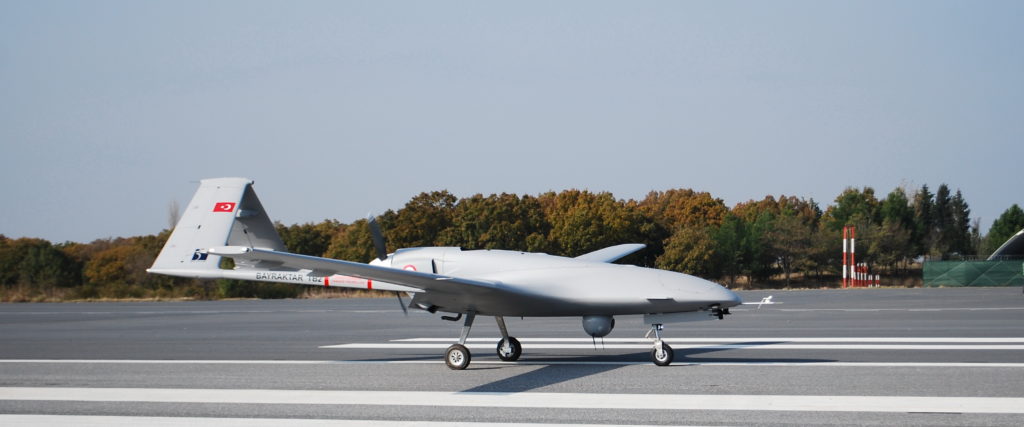
Tajik Minister of Defense Shir Ali Mirza with Mohammed Bagheri, chief of staff of the Iranian Armed Forces.
“God willing, in the future we will see more cooperation and interaction from all levels of military defense between Iran and Tajikistan.”
The excerpted article from one of Iran’s major economic newspapers, Eghtesad News, illustrates how Iran uses drones to secure diplomatic objectives. The article discusses Iran’s Army Chief of Staff General Mohammed Bagheri’s recent visit to Tajikistan, where he attended the inauguration of the Ababil-2 [RG1] drone plant in Dushanbe. In meetings with Tajik officials, Bagheri also discussed common defense of the border against the Taliban. Tehran appears not to have offered Tajikistan the rights to manufacture the Ababil-3 presumably to maintain its own qualitative military edge among regional states and because of Tajikistan’s continued warm relationship with the United States. The Ababil-3 is larger, has a reported flight endurance of eight hours, and a maximum ceiling of 15,000 feet.
While some countries, such as Turkey, export drones to cement partnerships with countries in Africa, the Middle East, and Europe, Iranian strategy differs as Iran authorizes the manufacture of its drones abroad. In addition to providing drones to allies, this strategy also gives Iran plausible deniability in the case of nonstate actors like Lebanon’s Hezbollah or Yemen’s Houthis using Iranian-made drones. It also creates international clients for ongoing military equipment and hardware sales.
Iran may have turned to drone diplomacy with Tajikistan for several reasons. Iran has long considered Tajikistan within its own cultural circle because of the common language—Tajik is a dialect of Persian (Farsi), the official language of Iran. However, Iran-Tajikistan relations have not always been smooth. Emomali Rahmon, who has dominated Tajikistan since 1994, resented Iran’s backing of the Islamic opposition during the civil war that dominated the first decade of Tajik independence. For its part, Tajikistan has buried its frustration with Iran and other regional states to make common cause against the Taliban in recent years.
Source:
“Eftetah-e Karkhaneh Tavalid-e Pehpad-e Irani Ababil-2 dar Tajikistan (Inauguration of the Iranian Ababil-2 UAV plant in Tajikistan), Eghtesad News (major Iranian economic newspaper), 17 May 2022. https://www.eghtesadnews.com/بخش-اخبار-سیاسی-57/495755-افتتاح-کارخانه-تولید-پهپاد-ایرانی-ابابیل-در-تاجیکستان
Inauguration of Ababil-2 UAV Plant in Tajikistan
In order to strengthen and develop joint defense and military cooperation between the two countries and with the efforts of defense industry experts of the Ministry of Defense and the support of the Armed Forces of the Islamic Republic of Iran, the Ababil-2 UAV plant was inaugurated in Dushanbe in the presence of General Bagheri and Minister of Defense Shir Ali Mirza and a high-ranking group of commanders in the Tajikistan capital of Dushanbe.
General Bagheri pointed out that the Islamic Republic of Iran, with the efforts of its committed specialists and scientists and using its internal capabilities, has been able to have a significant growth in all military and defense dimensions, especially drones. “Today we are in a position where we can export military equipment to allied and friendly countries in addition to meeting domestic needs in order to increase security and lasting peace,” he said. The Chief of General Staff of the Armed Forces described the opening of the Ababil-2 plant in Tajikistan as a turning point in military cooperation between the two countries, adding: “God willing, in the future we will see more cooperation and interaction from all levels of military defense between Iran and Tajikistan.”
Image Information:
Image: Tajik Minister of Defense Shir Ali Mirza with Mohammed Bagheri, chief of staff of the Iranian Armed Forces
Source: EghtesadNews; https://shorturl.at/hoFNW
NO ATTRIBUTION



